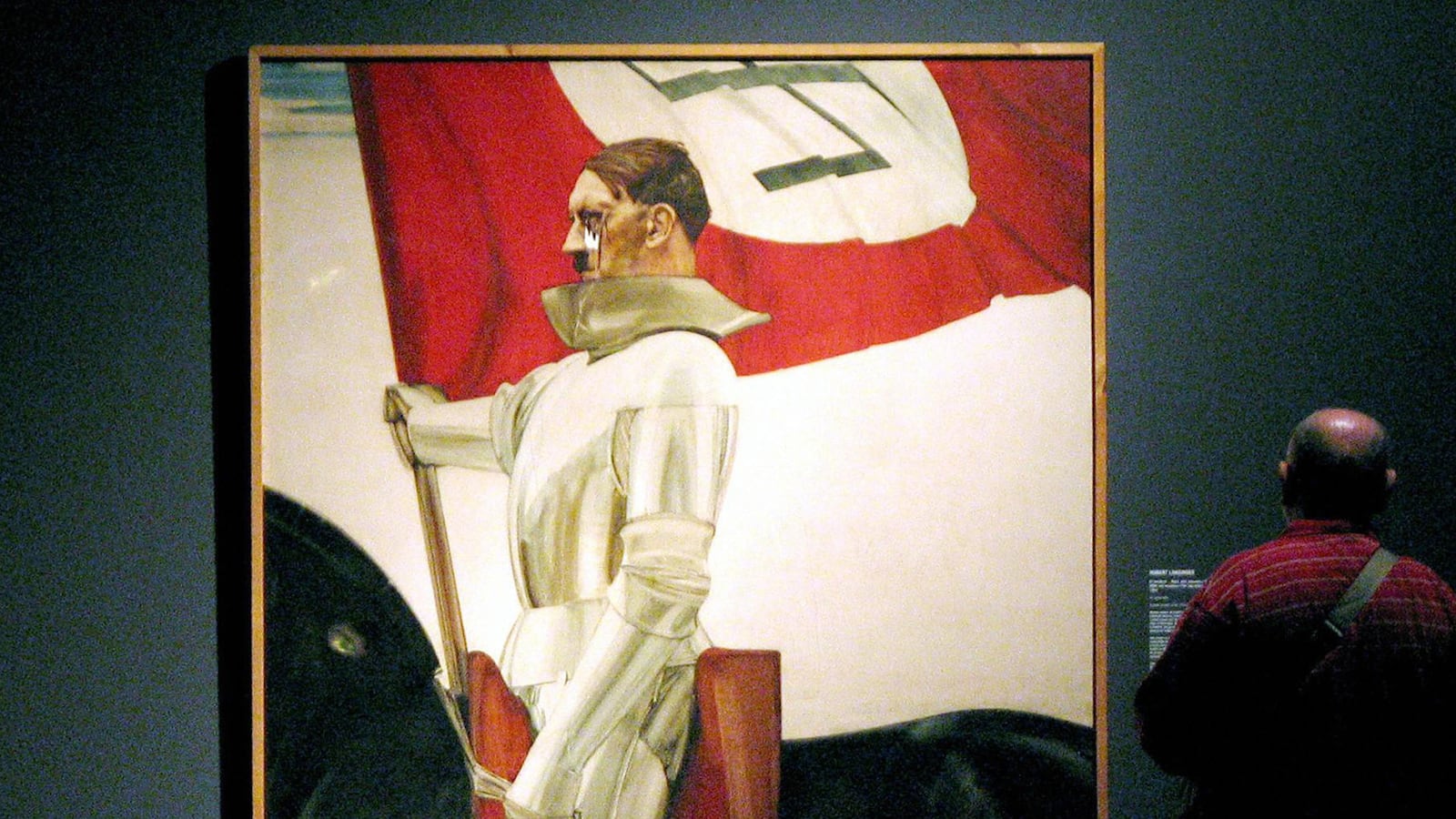
On the night of 10 April 1934, one of the twelve oak panels that comprise Jan van Eyck’s famous painting, Adoration of the Mystic Lamb, was stolen from Saint Bavo Cathedral, in Ghent, Belgium. Often referred to as “The Ghent Altarpiece,” this monumental oil painting is arguably the single most influential painting ever made. It is also the most-frequently stolen, having been burgled, in its entirety or in parts, at least six times—quite a feat, considering that it is the size of a barn door (14 x 11.5 feet) and weighs about two tons. It was the most-desired artwork by the Nazis, including Hitler and his second-in-command, Hermann Göring.
The two Nazi leaders actually raced one another to be the first to steal the altarpiece. The Nazi art theft unit, the ERR, captured it first for Hitler, from its hiding place at Chateau de Pau, in the south of France, where the Belgian government had sent it for safe-keeping. But an emissary from Göring appropriated it for the Luftwaffe head’s massive stolen art collection, which included some seven-thousand masterpieces, displayed at his country estate outside Berlin. Hitler got wind of this, and intercepted the altarpiece, sending it first to Castle Neuschwanstein in Bavaria, where it was restored, and then for storage in a salt mine in the Austrian Alps near Altaussee, where the twelve-thousand most famous stolen artworks from Nazi-occupied Europe were kept in secret, destined to feature in Hitler’s planned “super museum,” which would be the size of a city, and display every important artwork in the world. From the Altaussee salt mine, the Ghent Altarpiece and its fellow captives were ultimately rescued, thanks to the combined efforts of Austrian miners and a pair of Monuments Men, Robert Posey and Lincoln Kirstein, who only learned of the Altaussee hoard thanks to a fortuitous toothache that led them to a former SS officer, an art historian who was in hiding as the war drew to a close. The upcoming George Clooney film, The Monuments Men, dramatizes some of these stories, though taking a great many liberties in the process.
The iconography of The Ghent Altarpiece has long fascinated scholars. The painting was immediately the most famous in Europe, when it was completed in 1432. It was the first major oil painting. Oil had been used to bind pigments to paintings since the Middle Ages, but Jan van Eyck was the first to demonstrate the true potential of oils, which permit far greater subtlety and detail than largely-opaque egg-based tempera paint, which was preferred before The Ghent Altarpiece popularized oils. The altarpiece contains over 100 figures, and is an elaborate pantheon of Catholic mysticism—at its center stands a heavenly field, brimming with uniquely-depicted figures around a sacrificial lamb, representative of Christ (the Adoration of the Mystic Lamb from which the work draws it title). The lamb stands upon an altar and bleeds into a chalice—the Holy Grail.
Hitler so craved the Ghent Altarpiece because it was one of the most famous artworks in history, and it was by a Germanic artist, in the realistic, Northern Renaissance style that Hitler preferred. It had also been forcibly repatriated to Belgium after the First World War, before which certain panels of the altarpiece had been displayed in Berlin. The Treaty of Versailles mentioned only four works of cultural heritage, foremost among them The Ghent Altarpiece. Hitler wanted to correct the humiliation inflicted on the German people by the Treaty of Versailles, and recapturing the altarpiece would go some way toward that goal.
But there may also have been a more fantastic reason why Hitler wanted this painting above all others. Rumor had it that he was convinced that the painting contained a coded map to lost Catholic treasures, the so-called Arma Christi, or instruments of Christ’s Passion, including the Crown of Thorns, the Holy Grail, and the Spear of Destiny. Hitler believed that the possession of the Arma Christi would grant their owner supernatural powers. As the tide of the war turned ever more against the Nazis, Hitler cranked up his efforts to seek some supernatural way to bring victory to the Third Reich.
Cue the soundtrack to Indiana Jones and the Last Crusade.
The idea that the Nazis had teams of researchers hunting for supernatural treasures, religious relics, and entrances to a magical land of telepathic faeries and giants might sound like a bad History Channel documentary, or out-takes from an Indiana Jones movie. But despite the considerable popular interest in all things Nazi-related, and all things supernatural, relatively few people are aware of a very real organization that was the inspiration for the Indiana Jones plots: the Nazi Ahnenerbe, or the Ancestral Heritage Research and Teaching Organization.
The Ahnenerbe (which literally means “Inheritance of the Forefathers”) was a paranormal research group, established by order of SS head Heinrich Himmler on 1 July 1935. It was expanded during the Second World War on direct orders from the Fuhrer. Hitler and other top Nazi leaders’ (Himmler foremost among them) interest in the occult is well and widely documented. The Nazi Party actually began as an occult fraternity, before it morphed into a political party. Himmler’s SS, ostensibly Hitler’s bodyguard but in practice the leading special forces of the Nazi Army, was wholly designed based on occult beliefs. Wewelsburg, the castle headquarters of the SS, was the site of initiation rituals for twelve SS “knights” that was modeled on Arthurian legend. The magical powers of runes were invoked, and the Ahnenerbe logo features rune-style lettering. Psychics and astrologers were employed to attack the enemy and plan tactics based on the alignment of the stars. Nazis tried to create super-soldiers, using steroids, in a twisted interpretation of Nietzsche’s übermensch, and they sought to reanimate the dead—coffins of famous Germanic warriors were found hidden in a mine, with plans to bring them back to life at the war’s end.
The Ahnenerbe sent expeditions all over the world. To Tibet, to search for traces of the original, uncorrupted Aryan race, and for a creature called the Yeti, what we would call the Abominable Snowman. To Ethiopia, in search of the Ark of the Covenant. To the Languedoc, to find the Holy Grail. To steal the Spear of Destiny, which Longinus used to pierce Christ’s side as Christ hung on the cross, and which disappeared from a locked vault in Nurnberg. To Iceland, to find the entrance to a magical land of telepathic giants and faeries called Thule, which Hitler and most of the Nazi brass believed was the place of origin of the Aryans, and was very real. If they could find this entrance, believed to be accessible via a secret code hidden in a Medieval Icelandic saga called The Eddas, then the Nazis might accelerate their Aryan breeding program, and recover the supernatural powers of flight, telepathy and telekinesis that they believed their ancestors in Thule possessed, and which was lost due to inter-breeding with “lesser” races.
As crazy as all this may sound, it was fervently believed by many in the Nazi Party—so much so that huge sums of money were invested into research, along with hundreds of workers and scientists. This pseudo-scientific institute both sought supernatural advantages for the Nazi war effort, but also had a propagandistic agenda, to seek “scientific” evidence to support Nazi beliefs, like Aryan racial superiority.
With all this in mind, it is entirely plausible that Hitler believed that the Ghent Altarpiece contained a coded map to supernatural treasure. After all, the Ahnenerbe was hard at work looking for a secret entrance to the magical land of Thule in the Icelandic saga, The Eddas. Whether such a map is in The Ghent Altarpiece is another matter, one that scholars dismiss out of hand, though it is tempting to interpret the complex, enigmatic iconography and disguised symbolism of van Eyck’s masterpiece in terms more exotic than those in the average art history textbook. But there is also another component to the story that fuels this theory, and it is linked to the 1934 theft of that single panel.
There has never been a convincing explanation for the motivation for the theft of the Righteous Judges panel, referred to as such because it depicts a group of Biblical wise men (while also hiding several portraits, including one of van Eyck). While the man who masterminded the theft of the Judges panel, Arsene Goedertier, is known, he could not have acted alone, and his motivation is uncertain. The panel was ostensibly stolen in order to ransom it back to the bishopric of Saint Bavo—but Goedertier had more money in his bank account than was asked for in the ransom demand. For lack of a clear motive, various theories have arisen, one of which is linked to a Nazi art detective, Heinrich Köhn, who was sent to Ghent to find the stolen Judges panel several years before the Nazis seized the other eleven panels of the altarpiece.
Nazi Propaganda Minister Joseph Goebbels, along with Himmler, conceived of the idea to find the lost Judges panel and give it as a gift to Hitler at the tenth anniversary of his assumption of power in Germany, in 1943. Köhn investigated throughout the city of Ghent, even taking apart portions of the cathedral (for one theory held that the panel had been hidden on-site, never having left Saint Bavo). He found nothing, and was sent to fight in the Eastern Front for his failure. Why would the Nazis wish to locate a single stolen panel? They surely had designs on seizing the entire altarpiece, and did not wish it to be incomplete when they did so. Some have suggested that the coded treasure map leading to the Arma Christi was missing a key component that was hidden in the Judges panel. In order for the map to bear fruit, that panel was needed. It was stolen in 1934, therefore, to keep it out of Nazi hands, should the nascent Adolf Hitler follow through with his plan to recapture The Ghent Altarpiece and make it the focal point of his super-museum.
While there are plenty of non-supernatural, non-Da Vinci Code-y rationales for Hitler to desire The Ghent Altarpiece above all other objects, it is entirely plausible that Hitler might have believed in the coded treasure map theory. It seems far-fetched to us today, until we consider the other crazy theories that were truly believed by Hitler and his cronies. If The Eddas might contain a code to gain entrance to the magical land of Thule, where Aryan ancestors lived as flying telepathic faeries and giants then, according to Nazi logic, then the world’s most important painting might indeed contain a treasure map leading to the Holy Grail.





